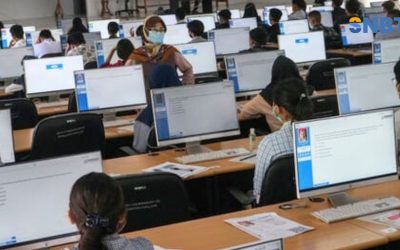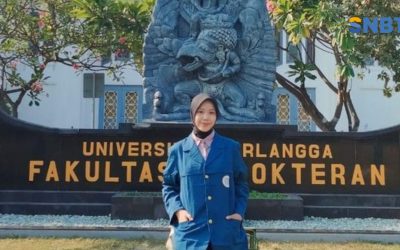Hai calon mahasiswa, selamat datang di halaman kami yang menyediakan latihan soal literasi bahasa Inggris.
Mulailah belajar sekarang juga dan persiapkan diri untuk ujian masuk perguruan tinggi.
Bersama kami, kamu bisa meraih masa depan yang lebih baik melalui jalur SNBT. Ayo mulai belajar!

Soal 1
Who perceived standardized testing provides an objective measurement of student performance?
a. James Andrew
b. Moriah Kent
c. Loren Kaplan
d. Connor Valadez
e. Jason Sanders
Answer: (B) Moriah Kent
Explanation: Moriah Kent argues that standardized test would remove the chance of bias because it is developed by experts, and each question undergoes an intense process to ensure its validity and reliability. Therefore, it talks about objectivity throughout the assessment.
Soal 2
The word “hinder” in James Andrew’s post is closest in meaning to ….
a. Release
b. Liberate
c. Obstruct
d. Determine
e. Provoke
Answer: (C) Obstruct
Explanation: The meaning of hinder is “to cause difficulty.” Therefore, the best answer is C.
Soal 3
What is the tone of the thread regarding the standardized test?
a. Encouraging
b. Passionate
c. Neutral
d. Argumentative
e. Humorous
Answer: (D) Argumentative
Explanation: The thread presents the arguments by some people based on their perceptions about standardized test. They are not likely to be neutral in this matter, and it is obvious that the text does not encourage people to do a particular action and it is far from being passionate or humorous. Therefore, the best answer is D.
Literasi Bahasa Inggris SNBT Latihan Soal Dan Pembahasan
Text 1
There was a forum on mining convened in Sydney by the Australian Centre for Space Engineering Research. The event brought together mining companies, robotics experts, lunar scientists, and government agencies that are all working to make space mining a reality. The forum comes hot on the heels of the 2012 unveiling of two private asteroid-mining firms. Planetary Resources of Washington says it will launch its first prospecting telescopes in two years, while Deep Space Industries of Virginia hopes to be harvesting metals from asteroids by 2020. Another commercial venture that sprung up in 2012, Golden Spike of Colorado, will be offering trips to the moon, including to potential lunar miners.
Within a few decades, these firms may be meeting earthly demands for precious metals, such as platinum and gold, and the rare earth elements vital for personal electronics, such as yttrium and lanthanum. But like the gold rush pioneers who transformed the western United States, the first space miners won’t just enrich themselves. They also hope to build an off-planet economy free of any bonds with Earth, in which the materials extracted and processed from the moon and asteroids are delivered for space-based projects. In this scenario, water mined from other worlds could become the most desired commodity. “In the desert, what’s worth more: a kilogram of gold or a kilogram of water?” asks Kris Zacny of HoneyBee Robotics in New York. “Gold is useless. Water will let you live.”
Water ice from the moon’s poles could be sent to astronauts on the International Space Station for drinking or as a radiation shield. Splitting water into oxygen and hydrogen makes spacecraft fuel, so ice-rich asteroids could become interplanetary refueling stations. Companies are eyeing the iron, silicon, and aluminum in lunar soil and asteroids, which could be used in 3D printers to make spare parts or machinery. Others want to turn space dirt into concrete for landing pads, shelters, and roads.
Text 2
The motivation for deep-space travel is shifting from discovery to economics. The past year has seen a flurry of proposals aimed at bringing celestial riches down to Earth. No doubt this will make a few billionaires even wealthier, but we all stand to gain: the mineral bounty and spin-off technologies could enrich us all. But before the miners start firing up their rockets, we should pause for thought. At first glance, space mining seems to sidestep most environmental concerns: there is (probably!) no life on asteroids, and thus no habitats to trash. But its consequences —both here on Earth and in space—merit careful consideration.
Part of this is about principles. Some will argue that space’s “magnificent desolation” is not ours to despoil, just as they argue that our own planet’s poles should remain pristine. Others will suggest that glutting ourselves on space’s riches is not an acceptable alternative to developing more sustainable ways of earthly life. History suggests that those will be hard lines to hold, and it may be difficult to persuade the public that such barren environments are worth preserving. After all, they exist in vast abundance, and even fewer people will experience them than have walked
through Antarctica’s icy landscapes.
There’s also the emerging off-world economy to consider. The resources that are valuable in orbit and beyond may be very different to those we prize on Earth. Questions of their stewardship have barely been broached—and the relevant legal and regulatory framework is fragmentary, to put it mildly. Space miners, like their earthly counterparts, are often reluctant to engage with such questions. One speaker at last week’s space-mining forum in Sydney, Australia, concluded with a plea that regulation should be avoided. But miners have much to gain from a broad agreement on the for-profit exploitation of space. Without consensus, claims will be disputed, investments risky, and the gains made insecure. It is in all of our long-term interests to seek one out.
Soal 4
Which of the following statements is an opinion from Text 1 and 2?
a. The forum comes hot on the heels of the 2012 unveiling of two private asteroid-mining firms.
b. Convened in Sydney by the Australian Centre for Space Engineering Research, the event brought together mining companies, robotics experts, lunar scientists, and government agencies that are all working to make space mining a reality.
c. But before the miners start firing up their rockets, we should pause for thought.
d. Splitting water into oxygen and hydrogen makes spacecraft fuel, so ice-rich asteroids could become interplanetary refueling stations. Without consensus, claims will be disputed, investments risky, and the gains made insecure.
Answer: (C) But before the miners start firing up their rockets, we should pause for thought.
Explanation: This sentence demonstrates the author suggestion towards the issue being discussed, as to what we should do. Meanwhile, another options talk about general information and facts.
Soal 5
What is the relationship between Texts 1 and 2?
a. Text 2 is not opinionated, while Text 2 is.
b. Text 2 refutes the central claim advanced in Text 1.
c. Text 2 illustrates the phenomenon described in more general terms in Text 1.
d. Text 2 expresses reservations about developments discussed in Text 1.
e. Text 2 argues against the practicality of the proposals put forth in Text 1.
Answer: (D) Text 2 expresses reservations about developments discussed in Text 1.
Explanation: The author of Text 1 is excited about the possibilities of space mining and how it can yield valuable materials, such as metals and elements, water ice, and space dirt. The author of Text 2, on the other hand, recognizes the possible benefits of space mining but also states that space mining should be thoughtfully considered before being implemented. Therefore, the author of Text 2 expresses some concerns about a concept discussed in Text 1.
Soal 6
According to Text 2, space mining has positive potential but…
a. It will end up encouraging humanity’s reckless treatment of the environment.
b. Its effects should be thoughtfully considered before it becomes a reality.
c. Such potential may not include replenishing key resources that are disappearing on Earth.
d. Experts disagree about the commercial viability of the discoveries it could yield
e. It could create unanticipated technological innovations.
Answer: (B) Its effects should be thoughtfully considered before it becomes a reality
Explanation: The author of Text 2 recognizes that space mining may prove beneficial to humanity, stating that “we all stand to gain: the mineral bounty and spin-off technologies could enrich us all”. The author also repeatedly mentions that space mining should be carefully considered before it is implemented: “But before the miners start firing up their rockets, we should pause for thought”; “But its consequences—both here on Earth and in space—merit careful consideration”.
Literasi Bahasa Inggris SNBT Latihan Soal Dan Pembahasan
Text 1
In 1894, British psychologist C. Lloyd Morgan published what’s called Morgan’s canon, the principle that suggestions of humanlike mental processes behind an animal’s behavior should be rejected if a simpler explanation will do. Still, people seem to maintain certain expectations, especially when it comes to birds and mammals. “We somehow want to prove they are as ‘smart’ as people,” zoologist Sara Shettleworth says. We want a bird that masters a vexing problem to be employing humanstyle insight.
New Caledonian crows face the high end of these expectations, as possibly the second-best toolmakers on the planet. Their tools are hooked sticks or strips made from spikeedged leaves, and they use them in the wild to winkle grubs out of crevices. Researcher Russell Gray first saw the process on a cold morning in a mountain forest in New Caledonia, an island chain east of Australia. Over the course of days, he and crow researcher Gavin Hunt had gotten wild crows used to finding meat tidbits in holes in a log. Once the birds were checking the log reliably, the researchers placed a spiky tropical pandanus plant beside the log and hid behind a blind.
A crow arrived. It hopped onto the pandanus plant, grabbed the spiked edge of one of the long straplike leaves and began a series of ripping motions. Instead of just tearing away one long strip, the bird ripped and nipped in a sequence to create a slanting stair-step edge on a leaf segment with a narrow point and a wide base. The process took only seconds. Then the bird dipped the narrow end of its leaf strip into a hole in the log, fished up the meat with the leaf-edge spikes, swallowed its prize and flew off. “That was my ‘oh wow’ moment,” Gray says. After the crow had vanished, he picked up the tool the bird had left behind. “I had a go, and I couldn’t do it,” he recalls. Fishing the meat out was tricky. It turned out that Gray was moving the leaf shard too forcefully instead of gently stroking the spines against the treat. The crow’s deft physical manipulation was what inspired Gray and Auckland colleague Alex Taylor to test other wild crows to see if they employed the seemingly insightful stringpulling solutions that some ravens, kea parrots and other brainiac birds are known to employ. Three of four crows passed that test on the first try.
Text 2
For one month after they left the nest, I led my four young ravens at least once and sometimes several times a day on thirty-minute walks. During these walks, I wrote down everything in their environment they pecked at. In the first sessions, I tried to be teacher. I touched specific objects— sticks, moss, rocks—and nothing that I touched remained untouched by them. They came to investigate what I had investigated, leading me to assume that young birds are aided in learning to identify food from the parents’ example. They also, however, contacted almost everything else that lay directly in their own paths. They soon became more independent by taking their own routes near mine. Even while walking along on their own, they pulled at leaves, grass stems, flowers, bark, pine needles, seeds, cones, clods of earth, and other objects they encountered. I wrote all this down, converting it to numbers. After they were thoroughly familiar with the background objects in these woods and started to ignore them, I seeded the path we would later walk together with objects they had never before encountered. Some of these were conspicuous food items: raspberries, dead meal worm beetles, and cooked corn kernels. Others were conspicuous and inedible: pebbles, glass chips, red winterberries. Still others were such highly cryptic foods as encased caddisfly larvae and moth cocoons. The results were dramatic.
The four young birds on our daily walks contacted all new objects preferentially. They picked them out at a rate of up to tens of thousands of times greater than background or previously contacted objects. The main initial criterion for pecking or picking anything up was its novelty. In subsequent trials, when the previously novel items were edible, they became preferred and the inedible objects became “background” items, just like the leaves, grass, and pebbles, even if they were highly conspicuous. These experiments showed that ravens’ curiosity ensures exposure to all or almost all items in the environment.
Soal 7
What is the main purpose of Text 1?
a. Offers historical background in order to question the uniqueness of two researchers’ findings.
b. Offers interpretive context in order to frame the discussion of an experiment and its results.
c. Introduces a scientific principle in order to show how an experiment’s outcomes validated that principle.
d. Presents seemingly contradictory stances in order to show how they can be reconciled empirically.
e. Illustrates some ways in which the ability to navigate long distances can help a species.
Answer: (B) Offers interpretive context in order to frame the discussion of an experiment and its results.
Explanation: Text 1 opens with an explanation of Morgan’s canon and continues with a discussion of people’s expectations regarding animal intelligence. Taken together, the first two paragraphs indicate that despite cautions to the contrary, people still tend to look for humanlike levels of intelligence in many animals, including birds. These two paragraphs provide a framework in which to assess the work of Gray and Hunt, presented in the rest of the passage. The passage’s characterization of the experiment Gray and Hunt conduct, in which they observe a crow’s tool-making ability and to which Gray responds by trying and failing to mimic the bird’s behavior (“I had a go, and I couldn’t do it,”), suggests that Shettleworth, quoted in the second paragraph, is at least partially correct in her assessment that “we somehow want to prove [birds] are as ‘smart’ as people”.
Soal 8
Which of the following best restates the second sentence in Paragraph 1 in Text 1?
a. Humans tend to have a particular expectations about some animals, especially birds and mammals.
b. People are not likely to expect things from birds and mammals as they are animals not humans.
c. Birds are inevitably expected to have certain specialties unlike mammals.
d. Both birds and mammals are unreliable for some people when it comes to expectation.
e. Many people believe that mammals are more reliable rather than birds.
Answer: (A) Humans tend to have a particular expectations about some animals, especially birds and mammals.
Explanation: The sentence highlights “Still, people seem to maintain certain expectations, especially when it comes to birds and mammals” which has the same meaning as the chosen option. However, another options are contradictive and false information.
Literasi Bahasa Inggris SNBT Latihan Soal Dan Pembahasan
Text 1
When I saw workingmen engaged with grave assiduity in fashioning weapons of death, I was struck with wonder at the shortsightedness of human beings, who were soberly preparing the instruments of destruction of their own species. I have since found upon a closer study of man, that my wonder might have been spared. The views of most individuals are limited to their own happiness, and the workmen whom I beheld so busy in the arsenal of Venice saw nothing but what was good in the labor for which they received such wages as procured them the comforts of life. That their immediate satisfaction was not hindered by a view of the remote consequential and contingent evils for which they were responsible would not surprise one who has had seen too much of the world. We must have the telescope of philosophy to make us perceive distant ills; further, we know that there are individuals of our species to whom the immediate misery of others is nothing in comparison with their own advantage—for we know that in every age there have been found men very willing to perform the office of executioner.
Text 2
With proper recognition of the possible variation of individuals, we can say that patriotism is one of these unalterable facts of man’s nature. A talent for fighting solidarity with a group is a part of the instinct of human beings. It is composed of two tendencies that are laid down in his nervous system when he is born called pugnacity and gregariousness, or group-loyalty. All men and most animals are pugnacious. They love to fight. Everybody loves to fight. Some people get all the
fighting they want at the breakfast table, and other people have to carry it out in the law courts or the battlefield, where it makes more noise. Roosevelt loves to charge up San Juan Hill, and then he loves to prosecute for libel anybody that says he didn’t charge up San Juan Hill. War people fight for war and peace people fight for peace. When Roosevelt calls the peace people mollycoddles and college sissies, I only want to walk up and smash him. It is far better though that we should conquer our instinct to fight and put faith in reason. It may seem gigantic; but it is by no means a utopian undertaking to unite the whole world of nations in such a federation. For all the organic interests of men, except their sheer love of patriotic fighting itself, are against the perpetual recurrence of international war. War and the mere joy of existence are incompatible. War makes it impossible to live, and it makes it impossible even to die for a noble purpose. Let men but understand themselves, and the mechanism of their emotions by which they are brought into this perennial catastrophe, and they will be ready enough to take gigantic measures to prevent it.
Soal 9
How would the author of Text 2 likely respond to the statement made by the author of Text 1 that, “the views of most individuals are limited to their own happiness”?
A. Most individuals lack the understanding to work for anything other than their own happiness.
B. Happiness can never come from patriotic fever.
C. Happiness is not relevant to the understanding of war.
D. Individual happiness is nonetheless often derived from group association.
E. Someone’s happiness may come from others’ happiness
Answer: (D) Individual happiness is nonetheless often derived from group association.
Explanation: The author of Text 2 makes numerous references to the construction of human identity and satisfaction through group association. He states that all human beings are born with a natural tendency towards group-loyalty, and it is clear that the author believes human beings derive happiness from patriotic association. The author of Text 2 would never agree that happiness is irrelevant to war or that it cannot be derived from patriotic fever. Likewise, the author of Text 2 clearly believes it is man’s nature to go to war and, as evidenced in the conclusion, that man can work to avoid war and consider the greater good. The author of Text 2 would view individual happiness and apathy as less significant to the cause of war and would place greater emphasis on group association.
Soal 10
Which of the following statements shows that the author in Text 2 longs to a life lived in peace?
A. War makes it impossible to live, and it makes it impossible even to die for a noble purpose.
B. A talent for fighting solidarity with a group is a part of the instinct of human beings.
C. Some people get all the fighting they want at the breakfast table, and other people have to carry it out in the law courts or the battlefield, where it makes more noise.
D. It is composed of two tendencies that are laid down in his nervous system when he is born called pugnacity and gregariousness, or group-loyalty.
E. Roosevelt loves to charge up San Juan Hill, and then he loves to prosecute for libel anybody that says he didn’t charge up San Juan Hill.
Answer: (A) War makes it impossible to live, and it makes it impossible even to die for a noble purpose
Explanation: The statement clearly shows that the author misses a peaceful life without war.
However, none of the other options indicates such statement.






